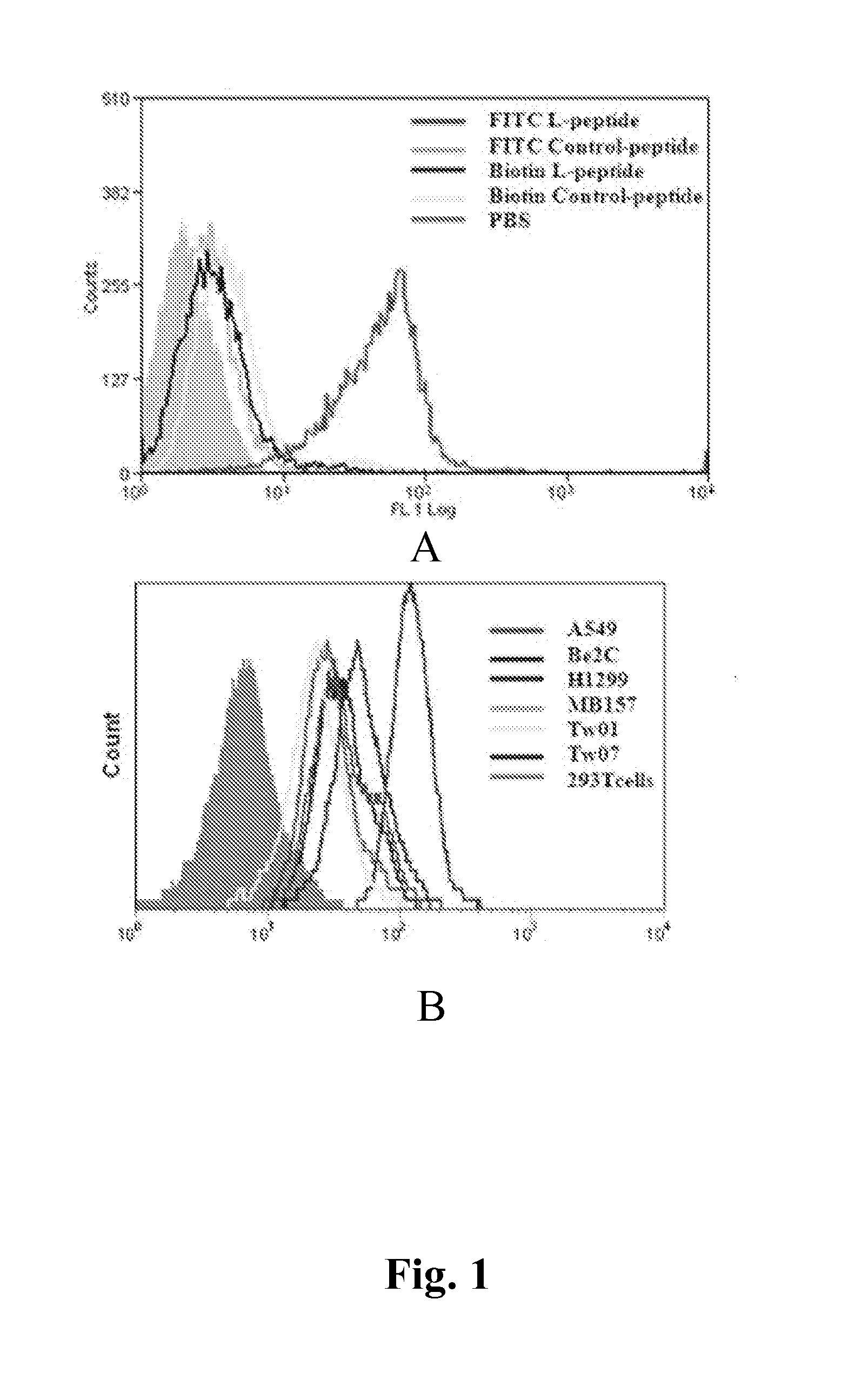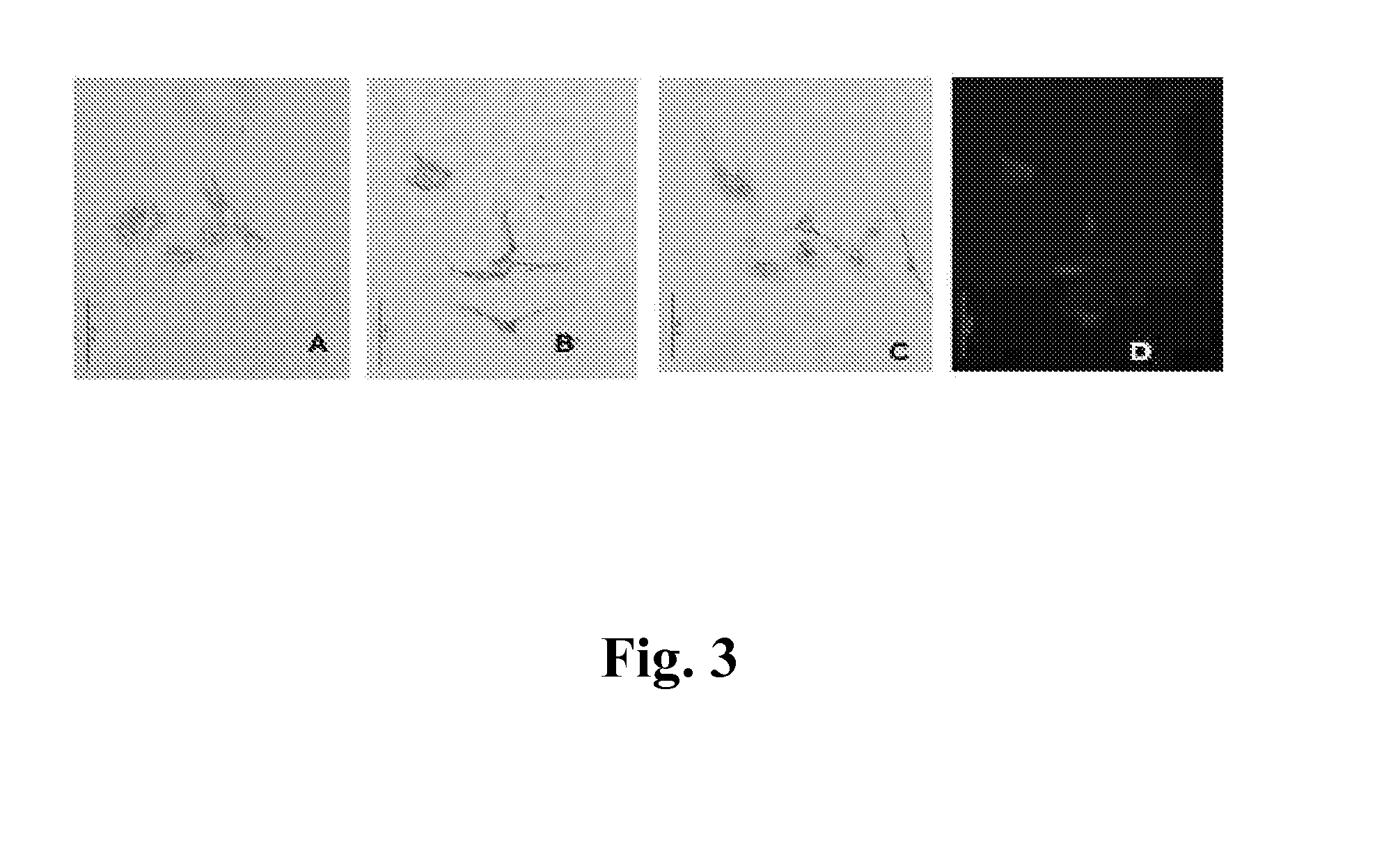Method for peptide histochemical diagnosis
a histochemical diagnosis and peptide technology, applied in the field of peptide histochemical diagnosis, can solve the problems of difficult to identify whether the peptide is present, poor result in paraffin-embedded surgical specimens, and inability to anticipate the efficacy of chemotherapy for cancer patients after surgery using this method, and achieves the effect of a small volume and more binding ability
- Summary
- Abstract
- Description
- Claims
- Application Information
AI Technical Summary
Benefits of technology
Problems solved by technology
Method used
Image
Examples
example 1
Synthesis and Characterization of Magnetic Nanoparticles
[0035]The dextran coated-Fe3O4 is linked with the targeted peptide SEQ ID NO:1 or the FITC-targeted peptide SEQ ID NO:1 by the MagQu Company. Dextran is used as the hydrophilic surfactant layer. The iron oxide fluid with the desired concentration is available by diluting the highly concentrated iron oxide fluid with a pH 7.4 phosphate buffered saline (PBS) solution. For iron oxide labeling, the NPC-TW01 cells are cultured for 24 hr, incubated with or without the targeted peptide SEQ ID NO:1-linked dextran-coated iron oxide nanoparticle (P-Dex-Fe3O4) at a concentration of 10 μg Fe3O4 / mL in the incubation media for 1 hr at 4° C. and incubated for 4 hr at 37° C. in a 10% CO2 incubator. Cells are washed in a 2% fetal bovine serum in PBS. After fixation, the binding ability between the targeted peptide SEQ ID NO: 1 and tumor cells can be observed by Prussian blue reagent; each iron oxide nanoparticle is bound by approximately above ...
example 2
Flow Cytometry Analysis of the Targeted Peptide SEQ ID NO: 1 Binding Cells in Different Cell Lines
[0036]The cultured cells, including nasopharyngeal carcinoma (NPC-TW01 and NPC-TW07), lung cancer (H1299 and A549), neuroblastoma (Be2C), breast cancer (MB157) and immortalized embryonic renal epithelia (TEKID) (239T) are subjected to flow cytometer (FACSCAN, BD Co., U.S.A.) after the FITC (Fluorescein isothiocyanate)-targeted peptide SEQ ID NO:1 treatment. Simultaneously, FITC-control peptide, FITC-biotin-targeted peptide SEQ ID NO: 1 (B-P) and FITC-biotin-control peptide (B-C-P) are used for flow cytometry comparison.
[0037]When NPC-TW07 cells are incubated with FITC-targeted peptide SEQ ID NO: 1, a clear peak is found in the histogram (FIG. 1A). When the targeted peptide SEQ ID NO: 1 is linked with biotin, very weak or no binding is seen. When other NPC cell line, such as NPC-TW01, and other cancer lines including lung cancer (A549 and H1299), neuroblastoma (Be2C) and breast cancer (M...
example 3
Localization of the Targeted Peptide SEQ ID NO: 1 in Nasopharyngeal Carcinoma
[0038]Because the targeted peptide SEQ ID NO:1 binds weakly to the cancer cells after conjugating to biotin, the sequence of this peptide was modified as Biotin-modified-peptide (B-m-P). B-m-P is modified by adding 5 amino acids spacer SEQ ID NO: 4 to N-terminal and linking with biotin. B-m-P can bind to the small surgical NPC specimens, but the result is not good enough to observe a clear reaction product. For the surgical specimens with more than 1 cm, B-m-P still can not bind to the surgical specimens, there is no binding phenomenon can be observed, while the targeted peptide SEQ ID NO:1-linked dextran-coated iron oxide nanoparticles (P-Dex-Fe3O4) of the present invention can bind to tumor cells and be stained with Prussian blue reagent. The result is excellent so as to name “peptide histochemical diagnosis”.
[0039]In the present invention, P-Dex-Fe3O4 has to be prepared at first. The nanoparticle (MW 60,...
PUM
| Property | Measurement | Unit |
|---|---|---|
| Pressure | aaaaa | aaaaa |
| Color | aaaaa | aaaaa |
Abstract
Description
Claims
Application Information
 Login to View More
Login to View More - R&D
- Intellectual Property
- Life Sciences
- Materials
- Tech Scout
- Unparalleled Data Quality
- Higher Quality Content
- 60% Fewer Hallucinations
Browse by: Latest US Patents, China's latest patents, Technical Efficacy Thesaurus, Application Domain, Technology Topic, Popular Technical Reports.
© 2025 PatSnap. All rights reserved.Legal|Privacy policy|Modern Slavery Act Transparency Statement|Sitemap|About US| Contact US: help@patsnap.com



